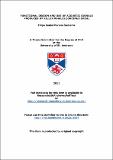Files in this item
Functional design and use of acoustic signals produced by killer whales (Orcinus orca)
Item metadata
| dc.contributor.advisor | Miller, Patrick | |
| dc.contributor.advisor | Harwood, John | |
| dc.contributor.author | Samarra, Filipa Isabel Pereira | |
| dc.coverage.spatial | xi, 141 | en_US |
| dc.date.accessioned | 2012-04-18T14:16:02Z | |
| dc.date.available | 2012-04-18T14:16:02Z | |
| dc.date.issued | 2011-11 | |
| dc.identifier | uk.bl.ethos.552678 | |
| dc.identifier.uri | https://hdl.handle.net/10023/2564 | |
| dc.description.abstract | This study aimed to investigate possible functions of the sounds produced by herring-eating killer whales in the Northeast Atlantic. In this study, I investigated the whistle repertoire of killer whales, which had previously only been studied in British Columbia, where it appeared to be restricted to the audible range. However, I show that high frequency whistles (> 17 kHz) were detected in Northeast Atlantic populations but not in Northeast Pacific populations. These results indicated substantial intraspecific variation in whistle production in killer whales. Little variation was observed in high frequency whistles recorded from three different sites in the Northeast Atlantic, suggesting this signal has a similar function across locations. The estimated active space of high frequency whistles and burst-pulse calls suggested that these are short-range signals used for within-group communication. Source levels of burst-pulse calls were lower than what was previously described in British Columbia, which possibly reflected the fact that these sounds do not need to propagate far because distances between group members are generally short. Calls, high frequency whistles and herding calls produced at different depths did not appear to suffer effects due to increased pressure, such as changing frequency or duration characteristics. Feeding appeared to take place below 10 m of depth, as suggested by the localisation of depth of production of feeding-related sounds. These depths were consistent with those at which tailslaps were produced in Dtags attached to individual whales. Feeding periods were characterised by deep diving, increased sound production and highly non-directional movement. These findings suggested that killer whales in a herring spawning ground use a feeding strategy different from carousel feeding used in herring overwintering grounds. These findings showed that Northeast Atlantic killer whales have a different sound repertoire to other populations, and suggested that they may employ different feeding strategies depending on prey behaviour. | en_US |
| dc.language.iso | en | en_US |
| dc.publisher | University of St Andrews | |
| dc.subject.lcc | QL737.C432S2 | |
| dc.subject.lcsh | Killer whale--Vocalization | en_US |
| dc.subject.lcsh | Killer whale--Behavior | en_US |
| dc.subject.lcsh | Killer whale--Food | en_US |
| dc.title | Functional design and use of acoustic signals produced by killer whales (Orcinus orca) | en_US |
| dc.type | Thesis | en_US |
| dc.type.qualificationlevel | Doctoral | en_US |
| dc.type.qualificationname | PhD Doctor of Philosophy | en_US |
| dc.publisher.institution | The University of St Andrews | en_US |
This item appears in the following Collection(s)
Items in the St Andrews Research Repository are protected by copyright, with all rights reserved, unless otherwise indicated.

